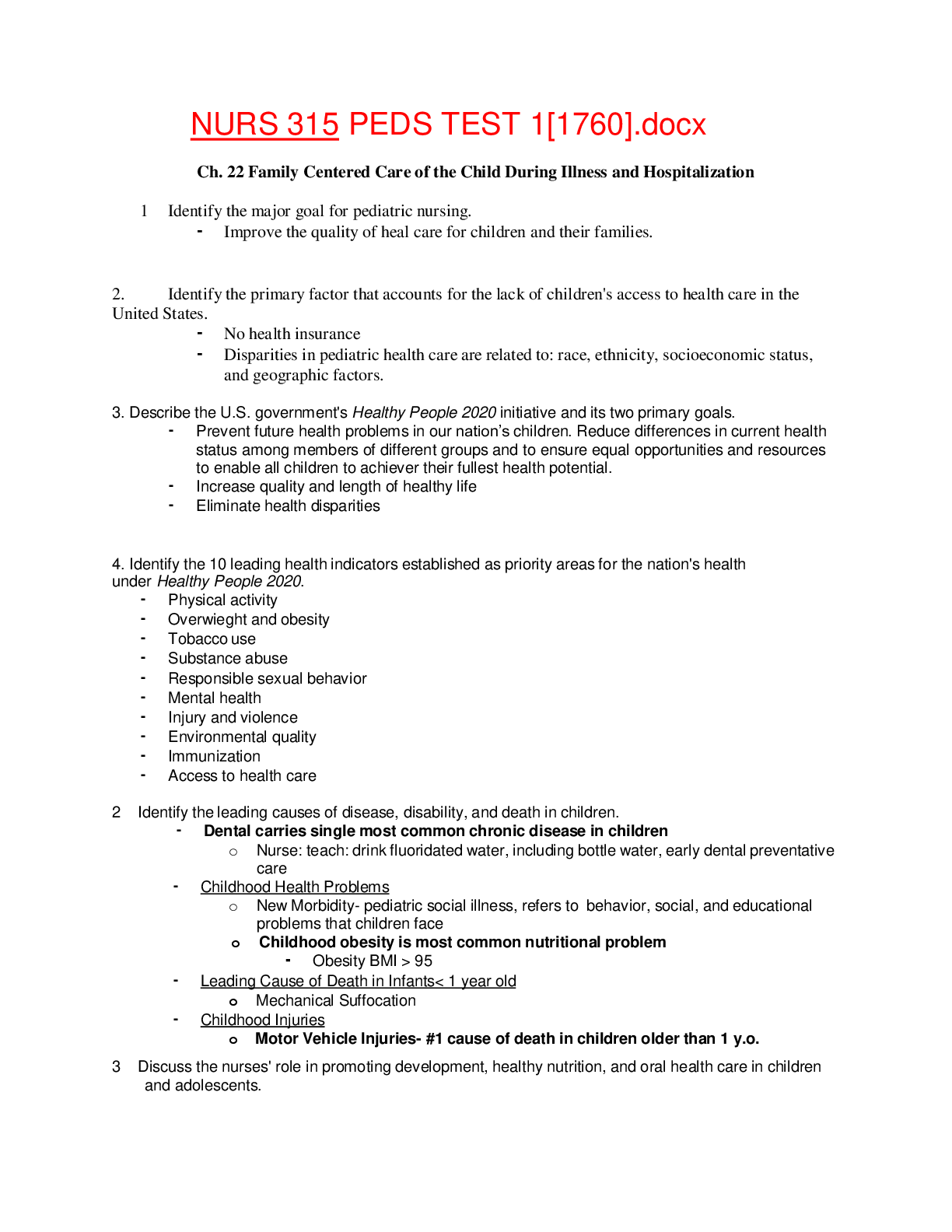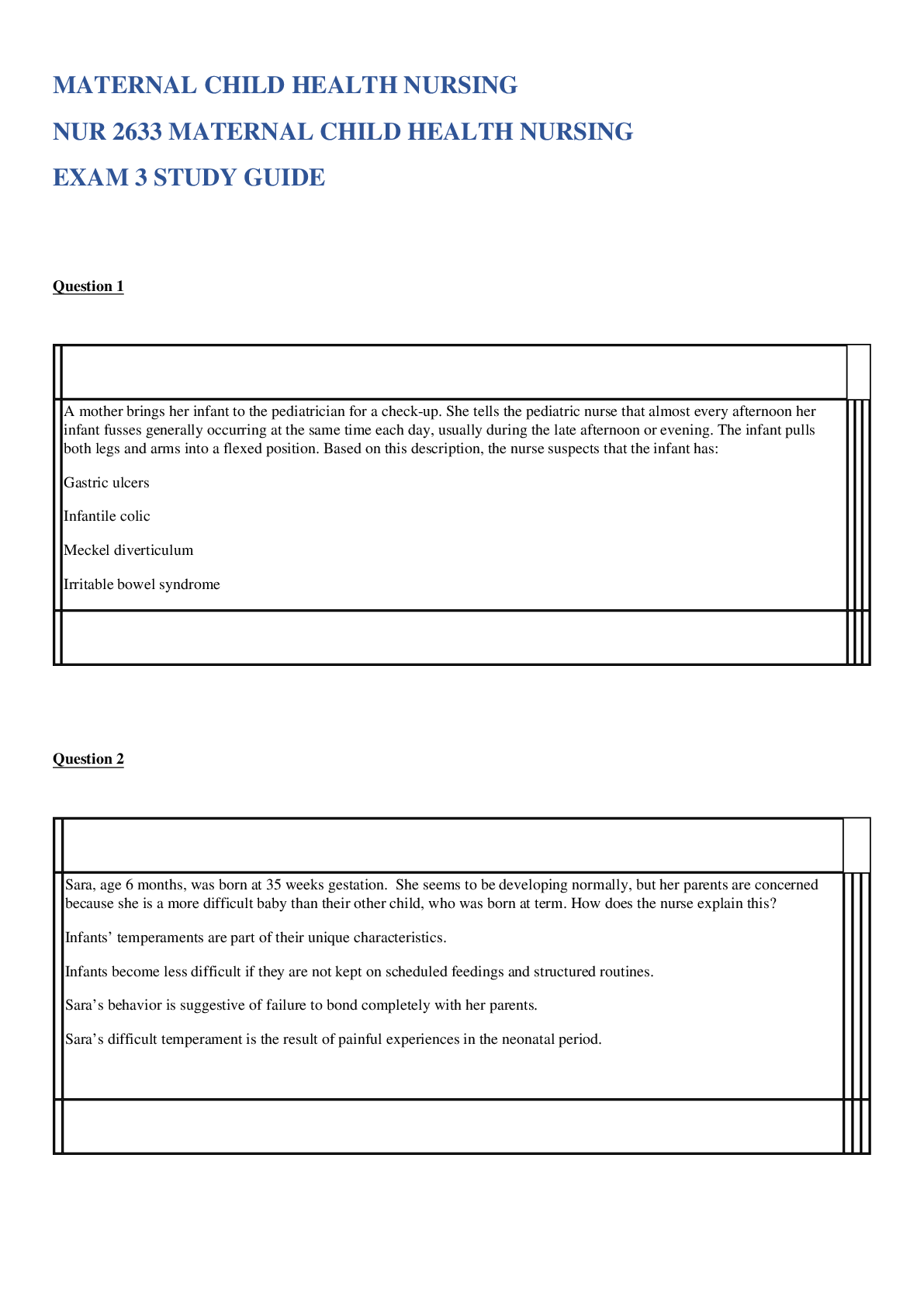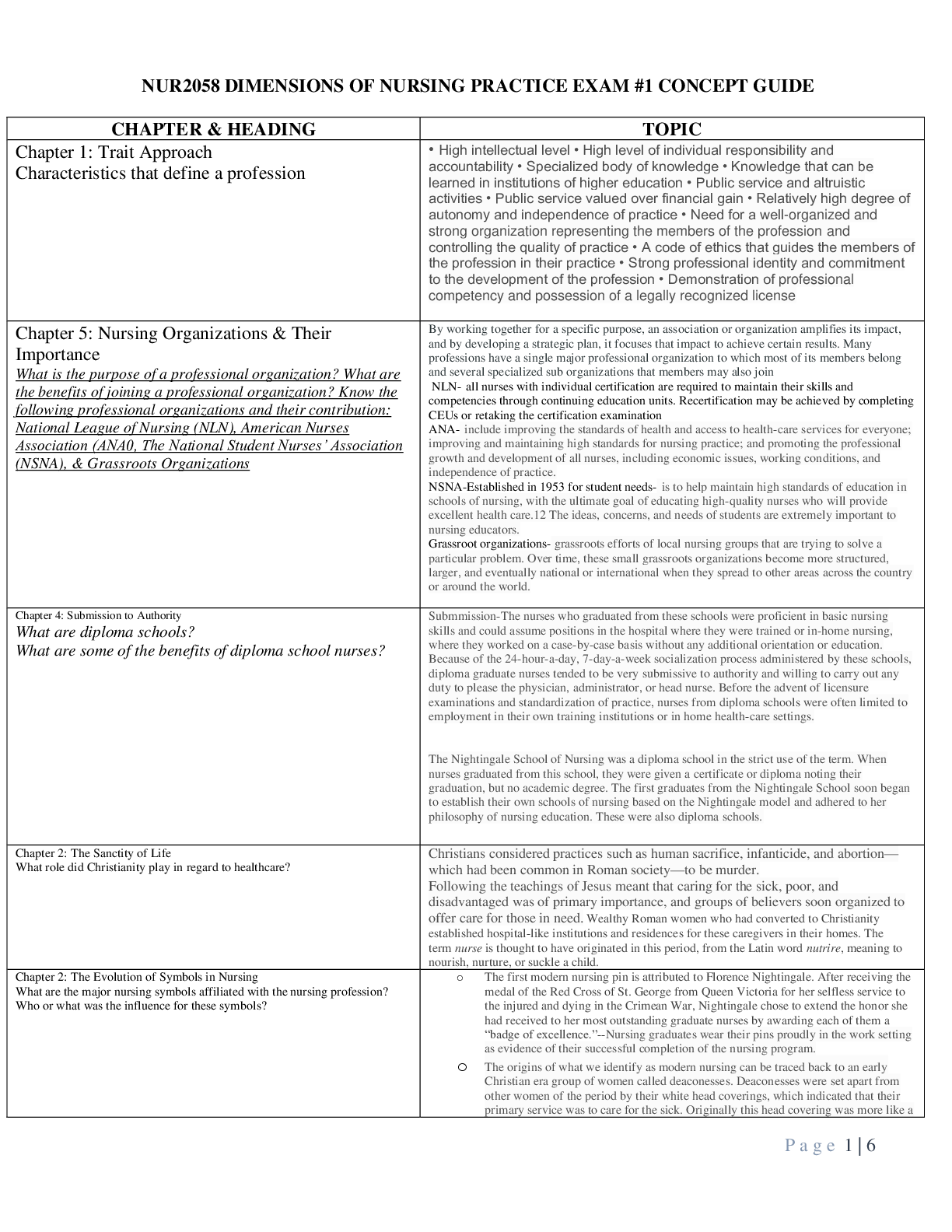*NURSING > EXAM > Ch. 1 Perspectives of Pediatric Nursing Ch. 22 Family Centered Care of the Child During Illness an (All)
Ch. 1 Perspectives of Pediatric Nursing Ch. 22 Family Centered Care of the Child During Illness and Hospitalization
Document Content and Description Below
Ch. 1 Perspectives of Pediatric Nursing Ch. 22 Family Centered Care of the Child During Illness and Hospitalization 1 Identify the major goal for pediatric nursing. 2. Identify the primar... y factor that accounts for the lack of children's access to health care in the United States. 3. Describe the U.S. government's Healthy People 2020 initiative and its two primary goals. 4. Identify the 10 leading health indicators established as priority areas for the nation's health under Healthy People 2020. 2 Identify the leading causes of disease, disability, and death in children. 3 Discuss the nurses' role in promoting development, healthy nutrition, and oral health care in children and adolescents. 4 Identify the factors that place infants and children at highest risk for health problems. 5 Define the term new morbidity and provide examples of health conditions this category comprises. 6 Discuss the etiology and consequences of major child and adolescent health problems-obesity and type 2 diabetes, childhood injuries, violence, and mental health problems-prevalent in the United States today. 7 Define the term mortality. • 8 Identify how live birth statistics and infant mortality rates are calculated. 9 Identify how the U.S. infant mortality rate compares with that of other developed countries. 13. Identify the one major indicator of infant and neonatal mortality in the United States. 14. List the leading causes of death for infants ages birth to 1 year. 15. Describe the disparity by race in U.S. infant mortality rates. 16. List the leading causes of death for children and adolescents ages 1 to 19 years. 17. List the major factors that contribute to increased morbidity among adolescents and children in the United States. • Barriers to health care, especially the homeless • Poverty • Improved survival of children with chronic health problems, particularly (VLBW) 18. Identify major characteristics of family-centered care. • Recognizes family as the constant in a child’s life • It’s an approach to planning, delivery, and evaluation of health care that is grounded in mutually beneficial partnerships among health care providers, patients, and families 19. Describe the concepts of enabling and empowerment. • Enabling- families are enabled by creating opportunities and means for all family members to display their current abilities and competencies and to acquire new ones to meet the needs of the child and family. • Empowerment- describes the interaction of professionals with families in such a way that families maintain or acquire a sense of control over their family lie and acknowledge positive changes that result from helping behaviors that foster their own strength. 20. Describe atraumatic care and the three principles underlying this approach. • Atraumatic Care- use of interventions that eliminate or minimize the psychologic and physical distress experienced by children and their families in the health care system. Ex. Of psychologic —preparing child for procedure • Goal is: o Prevent or minimize the child’s separation from the family o Promote a sense of control o Prevent or minimize bodily injury and pain ▪ Ex. Fostering the child-parent relationship during hospitalization ▪ Preparing the child before any unfamiliar treatment or procedure ▪ Controlling pain ▪ Allowing the child privacy ▪ Providing play activities for expression of fear and aggression ▪ Providing choices to children ▪ Respecting cultural differences 21. Discuss the following roles of the pediatric nurse: establishing therapeutic relationships; family advocacy and caring; disease prevention and health promotion; health teaching; injury prevention; support and counseling; coordination and collaboration; ethical decision-making; involvement with research. 22. Define evidence-based practice (EBP), discuss implications of EBP for nursing, and compare steps of the nursing process with EBP. 23. Define and state the purpose of clinical reasoning. 24. Describe the five steps in the nursing process (assessment, nursing diagnosis, planning, implementation, and evaluation). 25. Define quality of care and list the eight patient-centered quality outcome measures established by the National Quality Forum (NQF). 1 Discuss the typical stressors of and reactions to illness or hospitalization for children in each stage of development. Loss of Control: Infant’s Needs ● Trust ● Consistent loving caregivers ● Daily routines Loss of Control: Preschoolers ● Egocentric and magical thinking is typical of this age ● May view illness or hospitalization as punishment for misdeeds ● Preoperational thought Loss of Control: School-Age Children ● Striving for independence and productivity ● Fears of death, abandonment, permanent injury ● Boredom Loss of Control: Adolescents ● Struggle for independence and liberation ● Separation from the peer group ● May respond with anger and frustration ● Need for information about their condition 2 Identify three stages of young children's reactions to separation and behaviors observed in each phase. ● Separation anxiety ➢ Protest phase • Crying and screaming; clinging to the parent ➢ Despair phase • Crying stops; evidence of depression ➢ Detachment (denial) phase • Resignation but not contentment; superficial adjustment • May seriously affect attachment to the parent after separation -The major stressor for children from infancy through the preschool years is separation anxiety, 3 List common posthospitalization behaviors of young and older children. Young Children • Initial aloofness toward parents. Can last few minutes (common) to few days. Frequently followed by dependency behavior. • Cling to parents • Demand parent attention • Vigorous opposition to any separation • New fears (nightmares) • Resist going to bed • Withdrawal and shyness • Hyperactivity • Temper tantrums • Food pecularities • Attachment to blanket or toy • Regression newly learned skills (self toileting) Older Children • Negative Behavior: o Emotional coldness followed by intense, demanding dependence on parents o Anger towards parents o Jealousy toward others (siblings) 4 Discuss trends and changes in the hospitalized pediatric population. • Shortened hospital stays and outpatient surgery • Increased seriousness & complex problems of children • Fragile newborns and children with severe injuries or disabilities who have survived because of major technologic advances yet have been left with chronic or disabling conditions that require frequent and lengthy hospital stays 5 Identify common parental reactions to a child's illness or hospitalization and factors that influence these reactions. ● Disbelief, anger, guilt ➢ Especially if the illness has a sudden onset ● Fear, anxiety ➢ Related to the child’s pain and the seriousness of the illness ● Frustration ➢ Especially related to the need for information ● Depression 6 List common sibling reactions to the hospitalization of a child in the family. ● Loneliness, fear, worry ● Anger, resentment, jealousy ● Guilt 7 Discuss the significance of a philosophy of family-centered care in the pediatric clinical setting. ● Primary nursing goal ➢ Especially for children younger than 5 years of age ● Family-centered care ● Parents are not “visitors” ● Familiar items from home Normalizing” the Hospital Environment ● Maintain the child’s routine, if possible ● Time structuring ● Self-care (age appropriate) ● Schoolwork ● Friends and visitors 8 Identify functions of play for children in the hospital. • Provides diversion and brings about relaxation • Helps child feel more secure in strange environment • Lessens stress of separation and feeling of homesickness • Release of tension and expression of feelings • Encourages interaction and development of positive attitudes toward others • Expressive/creative outlet • Means to accomplish therapeutic goals • Opportunity to make choices and be in control 9 Identify ways that nurses can help minimize loss of control. • Promote Freedom of Movement o Infants & Toddlers—preserve parent-child contact, best way to decrease stress or need for physical restraint. • Preventing or Minimizing Fear of Bodily Injury o Beyond early infancy, all children fear bodily injury, mutilation, bodily intrusion, body image change, disability, or death o Use axillary temp instead of rectal o Toddler’s & Preschool have have poorly defined body boundaries, therefore using a band-aid after a shot calms their fears. Telling them, simply the bleeding will stop, does nothing. Size of bandage matters in this group.Smaller bandage=understanding their wound is healing • Maintaing the Child’s Routine and Independence o Establish daily schedule o Whenever “Self-Care” is possible, allow child to perform them o Anticipatory Preparation & Provision of Information- help lessen stress and increase understanding. Children feel in control when they know what to expect because the element of fear is reduced. 10 Identify components of the nursing admission history. According to Functional Health Patterns • Health Perception-Health Management Pattern o Why has your child been admitted? o How has your child’s general health been? • Nutrition-Metabolic Pattern o What is family’s usual mealtime? o Do family members eat together or at separate times? • Elimination Pattern o What are your child’s toileting habits? • Sleep-Rest Pattern o What is your child’s usual hour of sleep and awakening? • Activity-Exercise Pattern o What is your child’s schedule during the day o What favorite toys o Tv schedule • Cognitive-Perceptual Pattern o Does your child have any hearing difficulty o Have tubes been place in child’s ears o Glasses • Self-Perception-Self-Concept Pattern o How would you describe your child (takes time to adjust, settles in easily, shy, friendly, quiet, talkative, stubborn, easy going) o What makes your child angry, annoyed, anxious, or sad? What helps? o Does your child have any fears • Role-Relationship Pattern o Does child have nickname o Names of other family members o Parents occupation/work schedules o Child’ play companions. o How do handle discipline at home o Who staying with child during hospitalization • Sexuality-Reproductive Pattern (Apply to specific age group) o has child began puberty o how approach topics of sexuality o Adolescent Sexual Concerns- open ended question used terms “friends” or “partners” rather than “girlfriend” or “boyfriend” • Coping-Stress Tolerance Pattern o if upset, does child want special person or object o who does child talk to when worried about something • Value-belief Pattern o What is your religion o What religious practices would you like continued **Focus of admission hx is child’s psychosocial environment. Most questions directed to parent, depending on child’s age. 11 Explore examples of complementary therapies. o Nutrition, Diet, and Lifestyle or Behavioral Health Changes o Macrobiotics, megavitamins, diets, lifestyle modifications o Mind-Body Control Therapies o Biofeedback, relaxation, prayer therapy, guided imagery, hypnotherapy, music therapy, massage, aromatherapy, education therapy o Traditional and ethnomedicine Therapies o Acupuncture, ayurvedic medicine, herbal medicine, homeopathic, native American, traditional Asian o Structural Manipulation and Energetic Therapies o Accupressure, chiropractic, massage, reflexology, rolifing, therqpeutic touch, Qi Gong o Pharmacologic and Biologic Therapies o Antioxidants, cell tx, chelation therapy, metabolic therapy, oxidizing agents o Bioelectromagnetic Therapies o Diagnostic and therapeutic application of electromagnetic fields 12 List important considerations in planning for discharge and home care of the hospitalized or ill child. • Before beginning, explain instructions will be provided in writing • Provide overview of recovery • Discuss expected progression. Ex. Mary will probably sleep rest of day and feel tire tomorrow. • Explain which activities child allowed and what not allowed (bed rest, bathing) • Discuss dietary restrictions (clear fluids or full liquid diet) • Discuss nausea and vomiting • Discuss fever • Pain, give pain scale, give prescribed meds before leaving • Provide information about each medication • Make sure have all equipment/supplies • Discuss possible complications and how to handle them • Ensure pt has transportation • Provide emergency numbers for family to call • Explain a follow-up call will be made • Ask if have any questions. Miscellaneous: • If a toddler is not prepared for hospitalization, a typical preschooler fantasy is to attribute the hospitalization to punishment for real or imagined misdeeds. • School age/10 y.o.—more about maintaining control. Need to have control over their environment. • The most common initial reaction of parents to illness or injury and hospitalization in their child is? Disbelief. Then Anger or Guilt • Ch. 23 Pediactric Nursing Interventions & Skills 1 Discuss the conditions that must be met to obtain valid informed consent. • Capable of giving consent • Over age of majority—usually 18 • Considered competent • Must receive information needed to make an intelligent decision • Consent must be voluntary • Pt has right to accept or refuse any health care Requirements for Obtaining Informed Consent • Written informed consent of parent or legal guardian is required for medical or surgical treatment of a minor, including diagnostic procedures. One universal consent is not sufficient. Examples of procedures that need consent • Major surgery • Minor surgery: cutdown, biopsy, dental extraction, suturing, removal of cyst, closed reduction of fracture • Diagnostic test with element of risk (bronchoscopy, angiography, lumbar puncture, cardiac catheterization, bone marrow aspiration) • Medical tx with elements of risk: (blood transfusion, thoracentesis or paracentesis, radiotherapy) Other reasons for needing consent • Photo for medical/educational • Removal of child against medical advice • Postmortem exam, except in unexplained deaths, sucha s SID, violent death, or suspected suicide • Release of medical information • Decision making involving the care of older children and adolescents should include the pt.’s ASSENT as well as parent’s consent. ASSENT- means child or adolescent has been informed about the proposed tx, procedure, or research and is willing to permit a health care provider to perform it. • Assent should include: o Help pt achieve developmentally appropriate awareness of nature of his condition o Tell pt what is to be expected o Assess if pt understands o Solicit an expression of the pt.’s willingness to accept the proposed procedure • Use videos, peer discussion, diagrams, and written material • Nurse should provide assent form to be signed and child keep a copy • Assent is not a legal requirement, but an ethical one to protect the rights of children. Ch. 4 Communication, Physical, and Developmental Assessment What is the earliest age at which a satisfactory radial pulse can be taken in children? • 2 years old Binocularity is normally present by what age? • 3 to 4 months The nurse is testing an infant’s visual acuity. By what age should the infant be able to fix on and follow a target? • 3 to 4 months [Show More]
Last updated: 2 years ago
Preview 1 out of 13 pages

Buy this document to get the full access instantly
Instant Download Access after purchase
Buy NowInstant download
We Accept:

Reviews( 0 )
$18.50
Can't find what you want? Try our AI powered Search
Document information
Connected school, study & course
About the document
Uploaded On
Jul 11, 2021
Number of pages
13
Written in
Additional information
This document has been written for:
Uploaded
Jul 11, 2021
Downloads
0
Views
78
























